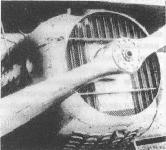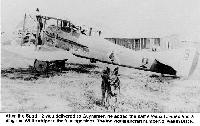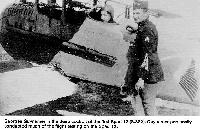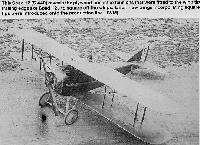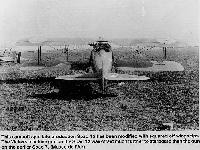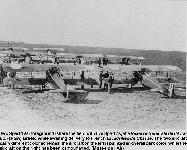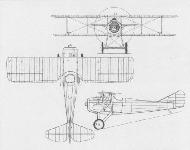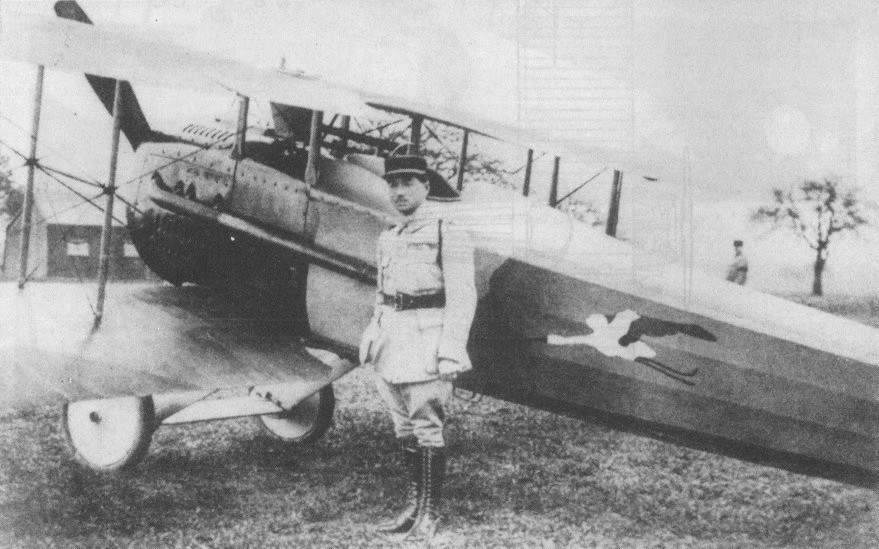
Описание
Страна: Франция
Год: 1916
Истребитель
Варианты
- SPAD - S.VII (Spa 7C-1) - 1916 - Франция
- SPAD - S.XI A.2 - 1916 - Франция
- SPAD - S.XII (Spa 12 C-1) - 1916 - Франция
- SPAD - S.XIII (Spa 13 C-1) - 1917 - Франция
- SPAD - S.XIV / S.XXIV - 1917 - Франция
- SPAD - S.XVI - 1917 - Франция
- SPAD - S.XVII / S.XXI - 1917 - Франция
- Bleriot-SPAD - S.22 - 1919 - Франция
- В.Кондратьев Самолеты первой мировой войны
- А.Шепс Самолеты Первой мировой войны. Страны Антанты
- J.Davilla, A.Soltan French Aircraft of the First World War (Flying Machines)
- W.Green, G.Swanborough The Complete Book of Fighters
-
Сайт - Pilots-and-planes /WWW/
This Spad 12 was flown by the commanding officer of the 13th Aero Squadron, United States Air Service, MAJ Charles J. Biddle
-
А.Шепс - Самолеты Первой мировой войны. Страны Антанты
Истребитель SPAD S.XII Cal, на котором летал Поль Рене Фонк (1917г.)
-
J.Davilla, A.Soltan - French Aircraft of the First World War /Flying Machines/
SPAD 12 of SPA 103.
-
В.Кондратьев - Самолеты первой мировой войны
Спад S XII, эскадрилья Spa-38, пилот - капитан Ф.Мадон, весна 1918г.
-
В.Кондратьев - Самолеты первой мировой войны
На этом пушечном истребителе "Спад" S XII с окрашенным в красный цвет фюзеляжем весной 1918г. летал французский капитан Ф.Мадон из эскадрильи SPA 38.
-
В.Кондратьев - Самолеты первой мировой войны
Французский ас Рене Фонк из эскадрильи "Аисты" (см. эмблему на борту) возле своего истребителя "Спад" S XII, на котором он сбил несколько германских самолетов на западном фронте.
-
K.Delve - World War One in the Air /Crowood/
'Ace of aces' Rene Fonck who was credited with 75 victories by the end of the war; his first operational posting had been to Escadrille C47 (flying Caudrons) in June 1915 as a Corporal Pilot.
-
В.Кондратьев - Самолеты первой мировой войны
Установка мотор-пушки на "Спаде"S XII
-
J.Davilla, A.Soltan - French Aircraft of the First World War /Flying Machines/
SPAD 12; the cannon (a 12-round, 37-mm S.A.M.C.) fired through the center of the propeller hub.
The cannon-armed S.XII never equipped a complete escadrille of the Aviation Militaire. -
J.Davilla, A.Soltan - French Aircraft of the First World War /Flying Machines/
SPAD 12. The most obvious changes from the SPAD 7 were the elimination of the tear-drop cylinder fairings and a more streamlined cowling.
-
Сайт - Pilots-and-planes /WWW/
After the Spad 12 was delivered to Guynemer, he added the name Vieux Chales and a diagonal White stripe to the fuselage sides. The individual aircraft number, 2, was in Black
-
Сайт - Pilots-and-planes /WWW/
Georges Guynemer in the deep cockpit of the first Spad 12 (S.382). Guynemer personally conducted much of the flight testing on the Spad 12
-
Сайт - Pilots-and-planes /WWW/
Guynemer displays his avion magique to General Francet d'Esperey at La Bonne Maison on 5 July 1917. Earlier that day, Guynemer had flown the first combat mission with the Spad 12, during which the aircraft was damaged. The wings of S.382 have been removed, pending its transport to Buc for repairs
-
H.Cowin - Aviation Pioneers /Osprey/
Georges Marie Ludovick Jules Guynemer is seen here briefing General Franchet d'Espery on the finer point of the SPAD VII's Hispano-Suiza engine in June 1917. Like the German fighter ace, Theo Osterkamp, Guynemer was initially rejected for military service on the grounds of his weak physique. Born in Paris on 24 December 1894, Guynemer befriended the local airfield commandant in order to enlist as an aircraft mechanic on 24 November 1914. Once in the service and with a little help from his well-placed father's contacts, Guynemer had been selected for pilot training by March 1915. As a corporal pilot, Georges joined Escadrille MS 3, flying a mix of single and two seat Morane-Saulniers. Initially given a two seater Type L, Guynemer scored an early victory, when he and his observer downed a two seat Aviatik during July 1915. By the end of 1915 Guynemer's unit was flying Nieuport 11s, becoming N 3 in the process. His score now stood at three. Commissioned in February 1916, Guynemer was wounded and missed most of the intensive air fighting over the Verdun area during the first half of 1916. Recovered, Georges rejoined N 3 just in time to take part in the Battle of the Somme, that opened on 1 July 1916. Guynemer experienced mixed luck on 23 September 1916, when, after downing three enemy aircraft, he, himself, narrowly missed death when his SPAD VII was shot out of the sky by 'friendly fire'. The culprit on this occasion was a 75mm French anti-aircraft shell that hit his machine at 9,000 feet. George was lucky to be able to get his fighter down for a crash landing. Sadly, luck finally deserted Guynemer on 11 September 1917, when the Legion d'Honneur holding ace was surprised by a flight of Albatros fighter and fell to their guns. At this time, Georges Guynemer had scored 45 confirmed victories.
-
Сайт - Pilots-and-planes /WWW/
An early Spad 12 (S.434) parked on a French airfield. Most units had one or two Spad 12s assigned to them, with instructions to allow the best pilots in the unit to fly the aircraft. This Spad 12 is believed to have been painted overall Light Grey
-
Сайт - Pilots-and-planes /WWW/
This Spad 12 (S.440) reveals the plywood pocket extensions that were fitted to the wing tips trailing edges of Spad 12s to square off the wings. Later, new wings incorporating square tips were introduced onto the production line
-
Сайт - Pilots-and-planes /WWW/
The other Spad 12 assigned to Fonck was S.445. Fonck's personal number, VI, was carried on the rear fuselage and repeated on the port upper wing surface in Red, outlined in White. The White-outlined Red star on the starboard wing was the former unit insignia of Spa.103
-
Сайт - Pilots-and-planes /WWW/
Spad 12s were progressively modified during production with new engines and other improvements. This late Spad 12 is powered by a 220 hp Hispano-Suiza 8Bc engine and has the louvered engine access panels removed for maintenance
-
J.Davilla, A.Soltan - French Aircraft of the First World War /Flying Machines/
Prototype SPAD 12 S.382 test flown by Guynemer - the underside was painted black.
This early Spad 12 reveals the revised cowling which lacked the prominent cylinder head fairings and repositioned exhaust stacks which were lower on the fuselage sides than on the earlier Spad 7. This aircraft was a test machine and had the fuselage undersurfaces painted Black -
Сайт - Pilots-and-planes /WWW/
This camouflaged late production Spad 12 has been modified with squared off wings tips. The Vickers machine gun on the Spad 12 was offset much further to starboard than the gun on the earlier Spad 7
-
Сайт - Pilots-and-planes /WWW/
Two Spad 12s (foreground) share the field with five Spad 7s, at Reserve Generale de l'Aviation (RGA) airfield while awaiting delivery to French Escadrilles de Chasse. The two aircrafts carry different color schemes; the aircraft on the left is painted an overall dark color, while the aircraft on the right has been camouflaged
-
W.Green, G.Swanborough - The Complete Book of Fighters
The S.XII which mounted a 37-mm cannon.
-
В.Кондратьев - Самолеты первой мировой войны
SPAD S XII
В.Кондратьев Самолеты первой мировой войны
SPAD S XII (Spa 12C-1)
"Спад" S XII - первый в мире истребитель с пушечным вооружением, созданный Луи Бешеро на базе "Спада" S VII в декабре 1916 года. S XII был оснащен 200-сильным мотором "Испано-Сюиза" 8C с понижающим шестеренчатым редуктором, что позволило установить на него, помимо синхронного пулемета "Виккерс", однозарядное полуавтоматическое орудие "Гочкис".
Пушка крепилась непосредственно к двигателю и размещалась между блоков цилиндров, а ствол проходил сквозь полый вал редуктора и ось винта. В автоматическом режиме происходило открывание затвора после выстрела и выброс гильзы, а заряжать орудие летчику приходилось вручную. Боекомплект составляли унитарные картечные патроны, каждый из которых содержал по шесть сферических чугунных пуль диаметром 18 мм. Патроны размещались в кассетах, укрепленных по бортам кабины.
Скорострельность орудия была довольно низкой, а ручное перезаряжание - весьма неудобным и отвлекавшим внимание пилота от ведения боя. Эффективная дальность картечного залпа не превышала нескольких десятков метров. К тому же после каждого выстрела кабину наполняли пороховые газы, что создавало летчику дополнительные неудобства и негативно влияло на его самочувствие. В результате всего этого S XII был признан неудачным и не получил широкого распространения. Хотя первоначальный заказ составлял 300 экземпляров, реально построили немногим больше 20. Серийные "спады" S XII на французских аэродромах.
Помимо вооружения, S XII отличался от предшественника слегка увеличенными геометрическими размерами, формой стабилизатора и вынесенным вперед для сохранения центровки верхним крылом.
Большинство серийных S XII поступило в знаменитую эскадрилью "Аисты", в которой служили многие выдающиеся асы Франции. Один экземпляр был отправлен для ознакомления в Англию, еще один - в США, но там к этим машинам не проявили интереса.
Описание:








